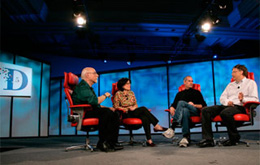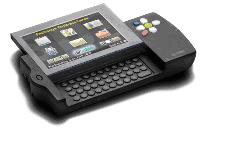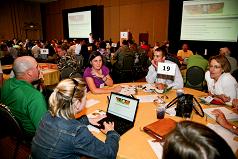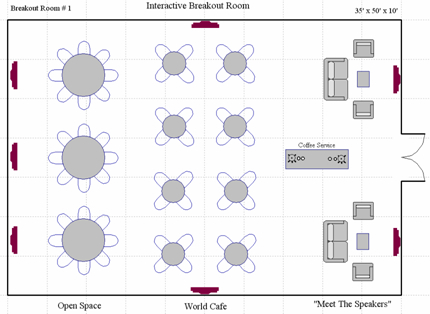A New Approach to Meeting Design:
Engaging Event Participants to Generate Bottom-line Results
Fearing negative publicity in the news or among shareholders, some companies have scaled back or canceled important events. These actions have weakened their ability to jump-start sales and profits. A recent article in Meeting Professional International’s (MPI) magazine One+ made clear, “Meetings are not the problem. They are part of the solution.
As the economy slowly makes its way back and meetings and customer events are being planned, we need to be pro-active in being part of the solution by designing meetings that engage event participants. We need to create agendas that will create new innovative ideas, better train employees and develop relationships to increase sales and profits.

Truth in Numbers
The U.S. Travel Association estimates that meetings and events are responsible for:
- Generating 15 percent of all travel-related spend
- Producing nearly $40 billion in tax revenue
- Creating more than one million jobs.
The tangible and intangible benefits of corporate meetings and events are equally compelling. Forrester Research estimates that while almost two-thirds of senior executives go to industry conferences to learn about new products and services, they also attend to meet other leaders, share ideas and develop productive relationships.
Other research shows that 53 percent of marketing and sales managers consider event marketing the best way to accelerate and deepen relationships with target audiences (EventView 2009, MPI).
The value of a meeting to facilitate greater employee engagement is also significant. The level of employee engagement can have a substantial impact on an organization’s bottom line. A recent study of more than 360,000 employees from 41 companies found that organizations described as having low overall employee engagement lost 2.01 percent operating margin and were down 1.38 percent in net profit margin over a three-year period. During that same period, high-engagement companies gained 3.1 percent operating margin and 2.1 percent net profit margin. According to the study, highly engaged employees clearly contributed to the bottom line (ISR, 2006).
The meetings industry provides invaluable economic and business contributions to individual companies and the economy as a whole. So the question for today’s meeting planners should not be whether or not to hold a meeting but rather what strategies should be developed and implemented to generate maximum ROI?
Engage for Greater Impact
Today, most people equate presentations with PowerPoint. As a result many companies operate in “Death by PowerPoint” mode. The assumption is that a well-polished PowerPoint presentation delivered from a beautifully-lit stage is all that’s needed to get a message across. PowerPoint debuted as an exciting medium, but after 20 years it has lost some of its ability to captivate. According to Edward Tufte, Professor Emeritus at Yale University, “PowerPoint actually reduces the analytical quality of serious presentations, and often weakens verbal and spatial thinking.”
PowerPoint has become less effective because the audience dynamic has changed. Most companies today are presenting to a new generation of tech-savvy individuals who demand a fresh approach; audiences want to be engaged rather than addressed. Accustomed to communicating in real-time via Instant Messenger, chat rooms and Twitter, meeting attendees seek to participate rather than merely listen.
Smart meeting designers are already effectively using these technologies to host virtual meetings and webinars; the real challenge is to incorporate these and other tools into face-to-face events for maximum impact.
The Value of Face-to-Face Communications is Unparalleled
Social scientists tell us that face-to-face communication is essential to building relationships, maintaining morale and keeping a business on track. Live meetings and events provide a valuable opportunity for businesses to effectively communicate as:
- Face-to-face feedback fosters honesty, openness, and in-depth communications as well as builds a stronger team.
- Persuading and encouraging an audience, especially during uncertain and rapidly changing times, builds trust, credibility and helps maintain a positive corporate image and workplace environment.
- In-person recognition and reinforcement of positive behavior is critical to building and maintaining morale and loyalty.
- Live meetings engage participants and are ideal for generating ideas and solving problems.
- Large numbers of participants can be educated and trained on new ideas, tools or technologies, quickly and efficiently.
The effectiveness of face-to-face interaction is central to the annual Wall Street Journal event, The D: All Things Digital. Their highly successful conference planners have scaled back on PowerPoint presentations in favor of live interviews between WSJ editors and speakers in lively, animated conversations.

Steve Jobs & Bill Gates at the Wall Street Journal Digital Conference
According to Gordon Crovitz, former publisher of the Wall Street Journal, “[This conference] is a dramatic example of how even the most digitally-minded people still thrive on human contact.” In his coverage, Crovitz details several significant interactions that occurred during the conference that would have been hard to capture remotely, in a news report, blog post, or even web cast. For example, Bill Gates held court around their outdoor dinner table for more than two hours discussing a variety of issues. Crovitz points out that attendees want to hear the unofficial story, rather than the sanitized press releases and corporate blogs that they get on-line. (“Social Networking in the Digital Age” by Gordon Crovitz, WSJ, June 2, 2008.)
Taking the aforementioned examples and approaches under consideration, there are several ways innovative meeting designers can increase participant engagement and maximize event ROI:
5 Steps to Achieve Maximum Meeting Impact
Step One – Build and empower the meeting design team
The most effective meetings leverage an experienced meeting design team whose members are responsible for key areas:
- Content. The meeting owner is responsible for developing the meeting’s learning, networking, and motivational goals based on the host organization’s business priorities.
- Design. The meeting architect structures the agenda, selects the most effective presentation methods and manages the budget.
- Execution. Typically, this is a small team that works with the meeting owner and architect to develop ideas to creatively accomplish meeting goals and objectives, as well as execute the plans in a timely, efficient and cost-effective manner.
Step Two – Align meeting design with business priorities
Successful meetings effectively align the learning, networking, and motivational goals with the correct support tools to help drive measurable results. To accomplish alignment the meeting owner must:
- Be specific. Be sure to detail each topic and sub-topic, outlining exactly what the audience is supposed to learn about each point.
- Educate. Good meetings teach the audience something new or remind them of something they had learned before. The core ideas behind teaching- explanation, reasoning, finding things out, questioning, content evidence and credible authority – should be woven into every presentation.
- Create networking opportunities. For most attendees, connecting with peers and making new contacts is a highlight of any conference, so allow ample time for interaction.
- Inspire and motivate. Meeting planners should ask the following questions before every event: What should the audience learn? How should the attendees feel when they leave? What actions should the individuals take as a result of this experience? Once these questions are answered you can identify ways to inspire and motivate your audience.
Step Three – Leverage technology
There are several new technologies that can make meetings more engaging:

- Spotme. This ingenious new tool enables social networking via a searchable photo database. It provides messaging, a unique people “Spotting” function, and electronic business card exchange. Spotme also includes a personalized agenda, audience response capability, Q&A session facilitation, lead retrieval, attendance tracking, and electronic feedback forms. Spotme is an ‘all-in-one’ communication system appropriate for any type of event with 200 to 5000 attendees.
- Social Networking. Spotme allows conference participants to network, communicate and build relationships during an event. The device can easily be used by an attendee to segment a registration list of 1,000 people, via multiple sorts, allowing him/her to identify the 15-20 most important people that he/she should network with while attending the conference.
- Audience Response Polling. This system also allows you to collect and instantly summarize thousands of live-voting responses. Data may even be automatically displayed in easy-to-understand pie charts and bar charts. Results are then summarized in easy-to-read reports delivered online at the event. Raw voting data is linked to respondent demographic information and available in an Excel-ready format for detailed data analysis and cross-tabulation.
- Q&A. Here attendees use keyboards to submit questions and comments, in real-time, as panelists are responding.
- FacilitatePro Collaborative Groupware. This collaboration software for high performance meetings is designed to replace the traditional flip-chart. It is an online tool that elevates participant engagement in the brainstorming process to a whole new level. Participant ideas are captured, by topic, as they are entered into a laptop computer. Once the brainstorming is complete, the group can review and discuss all of the ideas and prioritize action plans for each.

Step Four – The Human Touch
Every meeting planner’s arsenal should also include some good old fashioned, low-tech, high-touch activities. Here are some ideas that are effective and easy to execute:
- Senior leadership personally greets all attendees during the welcome reception.
- Crescent seating at rounds during the general session while a company leader “hosts” each table.
- Members of the leadership team seated among attendees during the general sessions.
- The organization’s president or other senior management spends time at each table during the sit-down dinner or awards banquet to thank everyone personally for their contributions or for attending.
- Senior managers and outside speakers who present at the meeting join the “Meet the Speakers” session (see page 9) so participants can interact with them personally.
Step Five – Integrate Messages with All Communications
Well-designed meetings maximize attendee participation and feedback. They also offer the perfect opportunity to persuade, encourage and recognize top performers via the most powerful medium of all-human interaction. As you develop your annual communications plans, consider how a well-designed meeting can leverage the power of face-to-face communications to deliver your messages, engage your attendees and improve your business results.
It is important to plan how critical meeting messages will be continually reinforced after the event. Consider intranet articles, newsletters, email, message board posts, small team meeting presentations, etc. to drive your messages home on an ongoing basis-and make sure they stick.
Ready, Get Set… Meet!
There’s no time like the present to start planning your next meeting. Use these ideas to make some exciting changes in the way you design your meetings. In doing this you will be able to harness the creativity, energy, and passion of your attendees and achieve results that will make a positive difference in your business.
Don’t forget that, first and foremost, today’s audiences want to be engaged. They want the opportunity to meet more people face-to-face. And they want to participate in the decision-making process and be a part of the future of their organization.
Appendix:Tips from Our Effective Meetings Toolbox
Esprit Productions has produced hundreds of successful meetings and events. Based on our vast experience and feedback from thousands of attendees, here are some suggestions to consider when planning your next event:
Handouts
Don’t miss an opportunity to develop a well-designed printed piece to support your sessions. A handout will help drive the content, as well as subsequent discussions and interactions. We recommend creating something as simple as an 11″ x 17″ sheet of paper in half to form a four-page document. Information in the handout should include:
- A written synopsis of the session, including the title, a statement of purpose/objectives, key points, and expected outcomes.
- High-resolution graphics and diagrams to support the copy. Eye-catching visuals will help foster thinking and exploration by the reader.
Keep in mind, written documents require more work than simply compiling a list of bullet points on slides. Writing out key points forces presenters to be clear and on task and provides attendees a take-away for later review.
Ask the audience to read the document before the session, or just as they walk-in. In the five minutes it takes to review the document, attendees will absorb much of the information. They can also write questions in the margins. This reading exercise helps convey messages clearly, reduces ‘preaching’ and selective dissonance, and leaves more time for in-depth interaction and discussion.
After the audience has read the document, the presenter should offer a brief synopsis (about 5 minutes) of the key points while using graphics from the handout to reinforce key messages. The presentation should then be framed with stories that support those key points. When possible, use “case studies” to support the content. Once the key points are reviewed and the stories are told, open the session to Q&A to ensure audience engagement, understanding, and buy-in.
General Sessions
The structure of most general session presentations includes one-way communication supported by PowerPoint. We recommend less PowerPoint and more interview-style presentations, moderated by a company executive, an editor from an industry magazine or a professional speaker/moderator. Brief comments to set the stage can be followed by “A Conversation With…”.
Questions are solicited by the moderator, through the live audience or can be garnered from your registration site, or the technology systems previously mentioned. This conversational, interview-style approach is guaranteed to elicit “golden nuggets” of information and the story or messages that your audience really wants to hear.
Breakouts, Concurrent Sessions and Workshops
Today’s breakout sessions and workshops are all about interaction. We recommend the following group seating configurations to make these sessions more engaging and productive.

- Open Space. This approach brings people together to discuss issues related to a specific topic. Participants volunteer to identify specific issues and then convene into small groups to discuss them. The group self-organizes to determine the agenda, examine the issues, and capture the output. A company staff member or other topical expert is often available to provide advice and discussion guidance.
- World Café. This arrangement creates a café-like atmosphere for participants to discuss their issues while sitting at small tables. At regular intervals, people move to different tables to learn something new about the topic-or, other, unrelated subjects. We call this approach “speed learning!”
- “Meet the Speakers.” One of the comments we hear most often is, “It would really be nice to meet the general session speakers.” This is a great opportunity for you to not only make a huge impression on attendees but also learn valuable insights from your constituents. Create a casual environment where participants can interact face-to-face with your executives or other industry experts after the general sessions.
Esprit Productions is a full service meeting, events and communications company focused exclusively on engaging your audience, inspiring enthusiasm, providing clarity, building esprit de corp and creating memorable moments for your audience.
Ron Springer
President & Executive Producer
Esprit Productions
520 N. Milwaukee Ave., Suite 10, Libertyville, IL 60048
847-549-6200 ext. 1 (o)/847-207-8333 (c)
rons@espritpro.com
